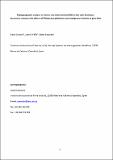Por favor, use este identificador para citar o enlazar a este item:
http://hdl.handle.net/10261/144232COMPARTIR / EXPORTAR:
 SHARE SHARE
 CORE
BASE CORE
BASE
|
|
| Visualizar otros formatos: MARC | Dublin Core | RDF | ORE | MODS | METS | DIDL | DATACITE | |

| Campo DC | Valor | Lengua/Idioma |
|---|---|---|
| dc.contributor.author | Cordero, David | - |
| dc.contributor.author | Peña, Juan B. | - |
| dc.contributor.author | Saavedra, Carlos Felipe | - |
| dc.date.accessioned | 2017-02-17T13:35:55Z | - |
| dc.date.available | 2017-02-17T13:35:55Z | - |
| dc.date.issued | 2014-02 | - |
| dc.identifier | issn: 1055-7903 | - |
| dc.identifier.citation | Molecular Phylogenetics and Evolution 71: 274-287 (2014) | - |
| dc.identifier.uri | http://hdl.handle.net/10261/144232 | - |
| dc.description.abstract | Studies on the phylogeography of species inhabiting the Mediterranean and the nearby coasts of the NE Atlantic Ocean (MEDAT) have found subdivision and/or phylogeographic structure in one or more of the Atlantic, western Mediterranean and eastern Mediterranean basins. This structure has been explained as the result of past population fragmentation caused by Pleistocene sea level changes and current patterns of marine circulation. However, the increasing use of nuclear markers has revealed that these two factors alone are not enough to explain the phylogeographic patterns, and an additional role has been suggested for endogenous barriers to gene flow or natural selection. In this article we examined the role of these factors in Ruditapes decussatus, a commercial clam species native to MEDAT. A genetic analysis of 11 populations was carried out by examining 6 introns with a PCR-RFLP technique. We found subdivision in three regions: Atlantic (ATL), western Mediterranean plus Tunisia (WMED), and Aegean and Adriatic seas (AEGAD). Two introns (Ech and Tbp) showed alleles that were restricted to AEGAD. Sequencing a subsample of individuals for these introns indicated that AEGAD-specific alleles were separate clades, thus revealing a phylogeographic brake at the WMED-AEGAD boundary. Sequencing of the mitochondrial COI locus confirmed this phylogeographic break. Dating of the AEGAD mitochondrial haplotypes and nuclear alleles with a Bayesian MCMC method revealed that they shared common ancestors in the Pleistocene. These results can be explained in the framework of Pleistocene sea level drops and patterns of gene flow in MEDAT. An additional observation was a lack of differentiation at COI between the ATL and WMED, in sharp contrast with 4 introns that showed clear genetic subdivision. Neutrality tests did not support the hypothesis of a selective sweep acting on mtDNA to explain the contrasting levels of differentiation between mitochondrial and nuclear markers across the ATL-WMED transition, and we argue that the difference between markers is best explained by the existence of an endogenous genetic barrier, rather than by a physical barrier to larval migration alone. | - |
| dc.description.sponsorship | This work has been funded by grants AGL2003-04143 from MCYT (Spain) and AGL2006-08944 from MEC (Spain) to J.B. Peña, and AGL2007-60049 and AGL2010-16743 from MICINN (Spain) to C. Saavedra. Partial funding was obtained from the Marine Genomics Europe Network of Excellence (GOCE 505403). | - |
| dc.publisher | Elsevier | - |
| dc.relation.isversionof | Postprint | - |
| dc.rights | openAccess | - |
| dc.subject | Gene flow | - |
| dc.subject | Endogenous barriers | - |
| dc.subject | Phylogeography | - |
| dc.subject | Mediterranean Sea | - |
| dc.subject | Selective sweeps | - |
| dc.title | Phylogeographic analysis of introns and mitochondrial DNA in the clam Ruditapes decussatus uncovers the effects of Pleistocene glaciations and endogenous barriers to gene flow | - |
| dc.type | artículo | - |
| dc.identifier.doi | 10.1016/j.ympev.2013.11.003 | - |
| dc.relation.publisherversion | https://doi.org/10.1016/j.ympev.2013.11.003 | - |
| dc.date.updated | 2017-02-17T13:35:55Z | - |
| dc.description.version | Peer Reviewed | - |
| dc.language.rfc3066 | eng | - |
| dc.contributor.funder | Ministerio de Ciencia y Tecnología (España) | - |
| dc.contributor.funder | Ministerio de Educación y Ciencia (España) | - |
| dc.contributor.funder | European Commission | - |
| dc.relation.csic | Sí | - |
| dc.identifier.funder | http://dx.doi.org/10.13039/501100006280 | es_ES |
| dc.identifier.funder | http://dx.doi.org/10.13039/501100000780 | es_ES |
| dc.type.coar | http://purl.org/coar/resource_type/c_6501 | es_ES |
| item.openairecristype | http://purl.org/coar/resource_type/c_18cf | - |
| item.fulltext | With Fulltext | - |
| item.cerifentitytype | Publications | - |
| item.openairetype | artículo | - |
| item.grantfulltext | open | - |
| Aparece en las colecciones: | (IATS) Artículos | |
Ficheros en este ítem:
| Fichero | Descripción | Tamaño | Formato | |
|---|---|---|---|---|
| Cordero et al - Phylogeographic analysis of introns and mitochondrial DNA.pdf | 1,14 MB | Adobe PDF |  Visualizar/Abrir |
CORE Recommender
SCOPUSTM
Citations
26
checked on 30-mar-2024
WEB OF SCIENCETM
Citations
25
checked on 21-feb-2024
Page view(s)
287
checked on 18-abr-2024
Download(s)
379
checked on 18-abr-2024
Google ScholarTM
Check
Altmetric
Altmetric
NOTA: Los ítems de Digital.CSIC están protegidos por copyright, con todos los derechos reservados, a menos que se indique lo contrario.
